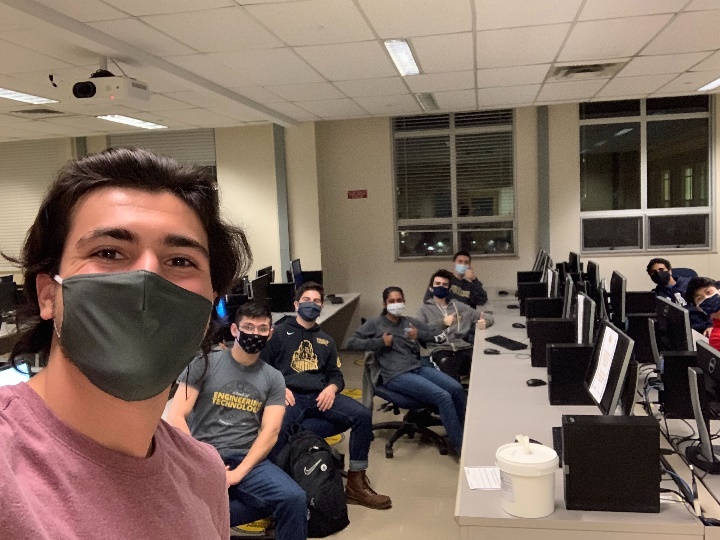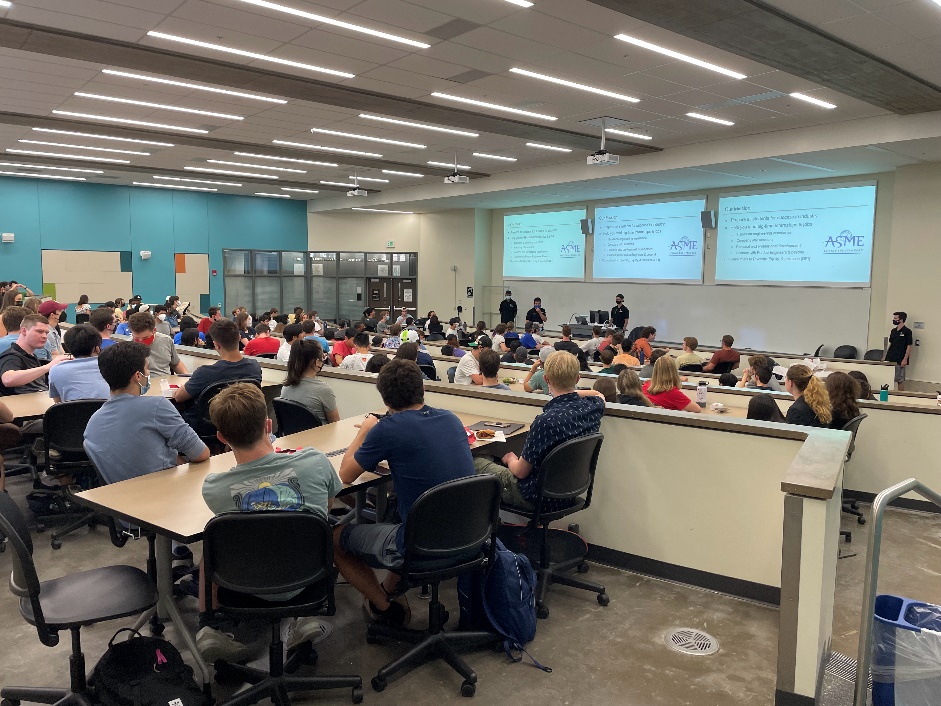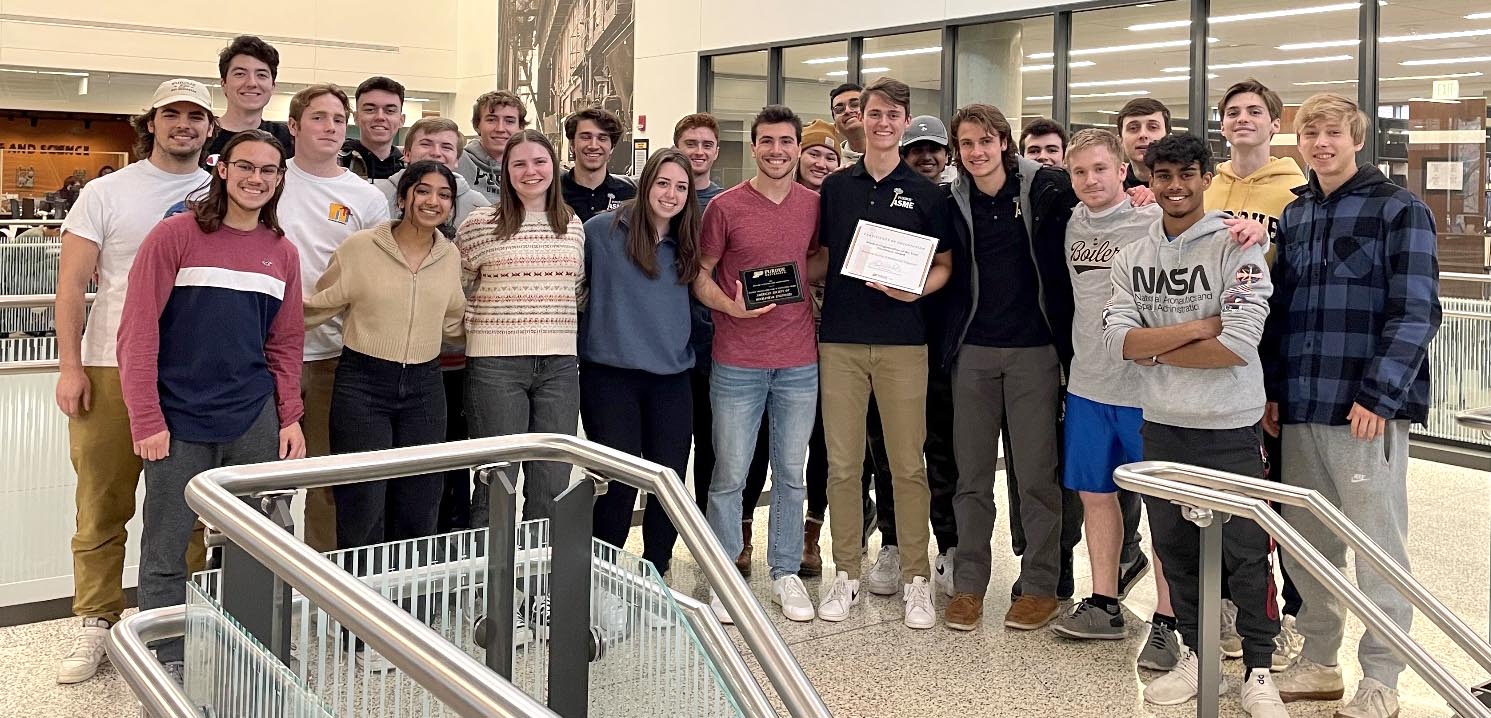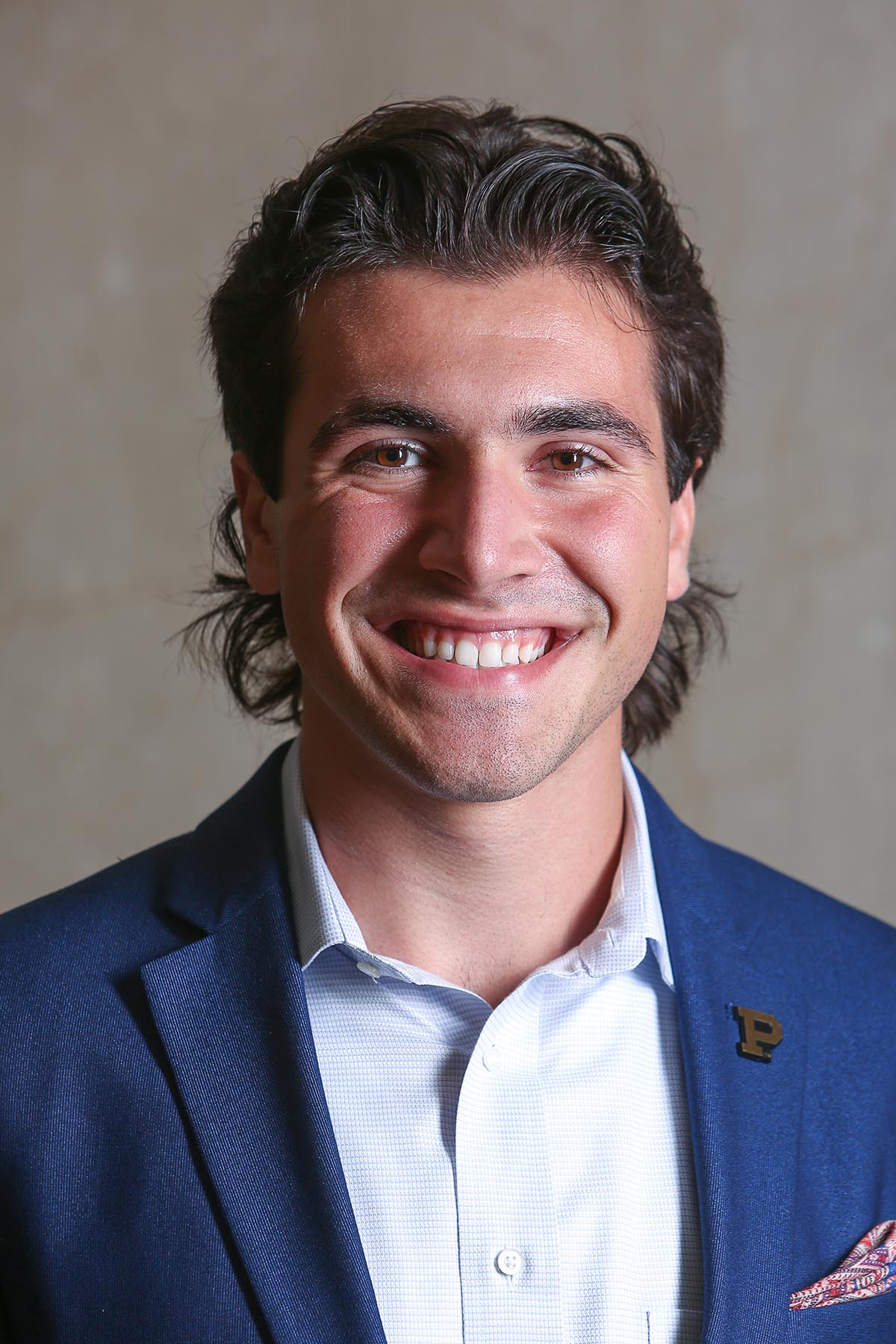18 lessons learned from growing an award-winning student organization: Marcus Lannie
1. Find Your Intersection Between Skills & Strengths
Skills are things you can learn, but strengths are innate to you and cannot be taught. Skills range from coding and CAD to surviving on ramen, but strengths include aspects such as a service-oriented mindset or desire to work with others.
“What’s CAD?” I asked during my first ASME meeting. You would’ve thought I had 3 heads the way those MEs looked at me! In my first month at Purdue, I attended callouts for more than 50 different student organizations with the goal of finding a group that combined my engineering skills and business acumen with my strengths of striving to use engineering to create a positive impact and passion for leadership. ASME had the perfect projects to do just that. I joined 10 clubs and eventually quit 8, but quitting frees up your time to find and excel at the intersection of what you like and what you’re good at. Contrary to what your parents told you, quitters can be winners.
2. Nobody Bleeds for the Prince in the Palace
Want your team to care about their work and succeed? Get your hands dirty with them.
In Fall 2020 at the peak of COVID restrictions, I was leading ASME’s only running team, the 10-person Sports Equipment Design team. After being elected VP, I directed all ASME’s technical activities, and even though I desired a more business-focused role, learning the ins and outs of our design teams would prepare me to be a stronger leader. In addition to leading all technical initiatives, I personally reached out to 200+ students to grow membership, handed out flyers on campus advertising the organization, and even remembered the names of all 100 students I met at our callouts. The work to get the ball rolling wasn’t glamorous, but it was worth every minute.

3. Stop Doing Useless Stuff
Cutting out the negatives isn’t enough. Eliminating both negatives and neutrals allows more room for positives.
“If it’s not working, why are we doing it?” “That’s the way we’ve always done it.” Before adding any new opportunities, I eliminated activities that didn’t provide value (even if every other organization ran them). I dropped all membership dues, paused general member meetings, and shortened company information sessions to 15 minutes. It’s easy to follow the lead of successful organizations, but you should only copy aspects that will actually benefit your organization. Eliminating negatives and neutrals before finding positives is scary, but you’ll never have time to pursue great opportunities if you’re wasting it on things without a significant ROI.
4. Purpose of Leadership
My purpose of leadership is not to be needed as a leader.
After our team stopped wasting time on unnecessary events, I had more time to develop the individuals around me into leaders who would eventually not require my leadership. I began crafting a vision to prepare ASME’s future leadership teams to succeed without relying upon any single leader. The core of this vision was the personal and professional development of potential leaders, and by prioritizing our members’ growth, the organization’s growth became inevitable.
5. Create a Direction, Not a Goal
Accomplishing goals is like taking baby steps, but without direction, baby steps will get you nowhere. Your direction determines where you want to go, and goals are how you will get there.
When I was elected President in Spring 2021, the ASME Purdue leadership team wrote the mission statement to be “ASME Purdue helps students land jobs and internships they love.” The updated statement enabled ASME to expand beyond its current offerings of solely ME-specific technical teams and identify new goals that aligned with the mission.
6. The More You Fail, The More You’ll Succeed
Organizations simply don’t fail enough. If you only run initiatives guaranteed to succeed, you slow the learning process and cease innovation.
Many of ASME’s new initiatives failed, but the initiatives that survived are now some of ASME’s most successful offerings. In Spring 2021, I co-founded ASME’s prosthetics team to design a hand for one of our member’s cousins in Italy who lost his hand in a meat grinder accident. Additionally, we debuted the Small Projects Team to undergo the entire engineering design process in one semester while working on unmanned aerial vehicles. These new teams were inclusive of all majors and allowed ASME’s reach to expand beyond just the ME department.
7. Who, Then What
It’s easy to have a position and find someone to fill it, but it’s more beneficial to find a person and make them a position.
I spent hours getting to know ASME members and learning about their interests. Instead of inviting them to pursue an already-made position, I would create an executive role for them to pursue their interest with the backing of ASME’s resources. From this method, ASME’s team grew to 30 executives and 75 members. The ratio seems lobsided, but building leadership infrastructure before we needed it saved the organization.
8. Delegate Problems, Not Solutions
“If somebody offers you an amazing opportunity but you are not sure you can do it, say yes – then learn how to do it later!” – Richard Branson
If you want to encourage member participation, empower members to own entire problems – not already-determined solutions. Our team identified a problem with too few MEs taking the FE exam; one member solved it by running FE study sessions led by ME Professors. Another member found a problem with our lack of income and solved it by setting up a team to systematically secure corporate sponsorships. Two members recognized the need for CAD education and teamed up to solve it by starting a CAD training program. Granting members freedom to own problems encourages creativity, cultivates innovation, and deepens commitment to the organization.
9. Start Your Team At “Trust Level 100”
In a new role, you start at “trust level 0” meaning you have to prove yourself through low-impact work. That’s slow and limits your potential.
How did I manage a team with 20 new direct reports exploring 20 new ideas? By starting them off at a “trust level 100”. Giving trust as opposed to slowly building trust allows members to show their potential and commitment more quickly while also instilling the confidence to try ideas without fearing a loss of trust in case of failure. With ASME’s executive team retention rate of 90%, this tactic accelerates the time until misaligned members leave and the time for high performers to be recognized and rewarded.
10. Quantity Over Quality
Want to get good at something? Do it a lot.
Improving a skill is very simple: do it, apply feedback, repeat. Pitching ASME to prospective members turned out to be a skill, and I had the perfect opportunity to refine it at Purdue’s B-Involved Fair. Every student organization is invited to the fair to recruit students before the Fall term begins, and I was fortunate to talk with 1,500 prospective members over 5 hours. With every pitch, I focused on applying just one piece of feedback received by the audience to tweak my next pitch, and after 5 straight hours of practice, I could pitch members in my sleep.

11. Make It Fun & Sexy
No one wants to join a club full of nerds. A club of fun nerds though? Heck yeah!
ASME holds 3 callout meetings every year to recruit prospective students. Based off previous years and factoring in our rapid growth from 10 to 75 members, I anticipated 70 attendees at each of the 3 callouts. Imagine how I felt when 170 people showed up to each callout. ASME grew to over 300 members with teams focused on sustainable engineering, Rube-Goldberg machines, remote-control ATVs, marine vehicles, engineering consulting, CAD training, FE exam preparation, and professional development workshops. After polling the attendees, the leading reason people joined ASME was the energy and vibe of the leadership team. Designing your culture to be fun is intentional, and one of my favorite ways we achieved this was factoring in a “sexiness” criterion when selecting design team projects.

12. Get Over Being Liked
The goal of branding is to both attract and repel individuals. Attracting individuals that don’t align with your mission in the long term is a waste of resources. You need to repel the wrong individuals just as much as you attract the right ones.
When your organization grows from 75 to 300 members in one semester, making every single person happy is quite difficult. As President, I had the distinct pleasure of being held accountable for any decision members disliked, but decisions need to be made for the betterment of the organization, not to appease a few members. I also proposed a new election process for the Purdue Engineering Presidents’ Council (PEPC), which created tension with a few organizations and built great relationships with others. If you try to make everyone happy, you’re going to make no one happy.
13. Are You Busy?
No, you’re not. You can work all day on something you love and feel energized, but when you work on something you don’t enjoy, you feel busy.
I was President of ASME, working remotely as a Product Manager for a San Francisco Bay Area company for 25 hours per week, making my daily Marcus’ Morning Minute (MMM) videos, and let’s not forget going to school! But I was never busy. College is a big game of prioritization, and I realized I could nearly eliminate anything I didn’t enjoy doing. Don’t like grocery shopping? Get them delivered. Getting bored with your extracurriculars? Find new ones. If you do things you love, you’ll never feel busy.
14. Don’t Go All In Too Early
The grass isn’t always greener, but you should at least check.
I encouraged our ASME team to join other organizations to see if they would find those offerings more valuable than ASME’s opportunities. Telling members to leave your organization might seem counterintuitive, but it aligns with ASME’s mission of helping students land jobs and internships, regardless if it’s through ASME’s offerings. Going all-in to an opportunity before exploring alternatives is a great way to believe the grass is always greener on the other side. Testing out new organizations requires minimal effort but quickly teaches members more about their personal interests and professional aspirations, and nearly every ASME member has come back to ASME fully dedicated and engaged.
15. Are You Running the Organization or Is the Organization Running You?
The leader of an organization needs time and energy to be strategic. Sprinting to keep up with growth forces leaders to become reactive and ineffective.
After lightning-fast growth to 300 members, I was struggling to dedicate time to identify new initiatives because I was so focused on keeping up with growth. Studying startups, global corporations, and other student organizations gave me the idea to split the VP role into 3 separate VP roles (Internal, External, Marketing) and add in a director reporting to each VP. Creating more roles for tactically focused leaders enabled more strategic decisions at all levels of the organization. Purdue ASME’s leadership structure is lauded by student organizations at Purdue and by ASME student chapters and student organizations around the world whose leaders frequently reach out for leadership consulting.
16. Facing Founderitis
Watching a new team take over leadership, especially when they’re making changes you don’t totally agree with, is rough. But for the sake of the organization, don’t get too involved.
I handed the ASME reigns off to a new executive team, and now it was time to rebrand myself without the title of ASME President. The team began a board of directors and offered me the Chairman of the Board position. It’s tough to sit back and watch while your team forges ahead, so I went and found other hobbies including public speaking, studying startups, and leadership consulting to utilize my experience as ASME President while reallocating my time away from ASME. The new leadership team expanded the organization to include two sustainability teams, start a podcast that featured Purdue President Mitch Daniels and ASME CEO Thomas Costabile, and revitalize the Grand Prix team. I trusted in my new leadership team’s ability to make great decisions, and membership continues to grow and now exceeds 450 students thanks to these new leaders’ innovative ideas.
17. Diversity Drives Innovation
Frans Johansson, author of my favorite book The Medici Effect, asserts that the greatest ideas come to life by bringing together diverse perspectives.
When I became President, students identifying with minority groups represented only 10% of ASME’s members and 10% of leadership, but at the end of my tenure and through my efforts amplifying minority voices and perspectives, students identifying with minority groups represented 40% of ASME’s members and 50% of leadership. In Spring 2022, I spearheaded ASME’s addition of a diversity, equity, and inclusion (DEI) committee and led ASME’s efforts supporting the Society of Women Engineers’ (SWE) response to President Mitch Daniels’ 2022 Open Letter.

18. Avoid the Hype Cycle
Winning awards and gaining recognition is a lot of fun, but mission-driven teams filter the noise and leverage awards to create an even greater positive impact.
In Spring 2022, ASME received SAO’s “Year of Excellence” Award for the most outstanding student organization in 2021-2022. It’s considered a lifetime achievement award, which is quite funny seeing as 3 semesters earlier we had only 10 members. Additionally, I was the first ASME member to be named a Purdue Engineering Fellow, the highest engineering honor for a Purdue undergraduate, and first ASME winner of the School of Mechanical Engineering Outstanding Junior Award. This year, ASME leaders from all grade levels were nominated for the School of ME’s 2022 Outstanding Student Awards and won the sophomore and junior awards. Winning prestigious awards often zaps a team’s drive as they go into cruise control to maintain growth, but ASME has instead leveraged these awards to recruit more members and accelerate growth. Filtering the negatives and embracing the positives from winning awards allows ASME to continue creating an impact at Purdue and in the engineering community.
 As President of Purdue’s chapter of the American Society of Mechanical Engineers (ASME), Marcus Lannie grew the organization from 10 to 300 members, and he continues to serve as Chairman of the Board advising the 50-person executive team on effectively leading ASME’s current 450 members. Marcus has interned with 4 companies in roles including Program Management, Mechanical Engineering, Sales & Marketing, and Management Consulting, and Marcus currently works as a Product Manager for A-Laser.
As President of Purdue’s chapter of the American Society of Mechanical Engineers (ASME), Marcus Lannie grew the organization from 10 to 300 members, and he continues to serve as Chairman of the Board advising the 50-person executive team on effectively leading ASME’s current 450 members. Marcus has interned with 4 companies in roles including Program Management, Mechanical Engineering, Sales & Marketing, and Management Consulting, and Marcus currently works as a Product Manager for A-Laser.
For his notable accomplishments, the College of Engineering named Marcus an Engineering Fellow, the highest engineering honor at Purdue. Marcus is best-known for his “Marcus’ Morning Minute” (#MMM) LinkedIn video series where he has been sharing minute-long videos for over 2 years and generated more than 2 million views. He now receives invitations to speak to student groups from around the world about leadership and LinkedIn. After graduating from Purdue in only 3 years with a BS in Mechanical Engineering and minors in Economics and Intercultural Communication, Marcus will be pursuing his Master’s in ME with a concentration in Product Design from UC Berkeley.
If you are interested in discussing the points above or booking Marcus to speak about student leadership, LinkedIn, personal branding, networking, or his signature “Secrets to Success: College Edition,” he can be reached via LinkedIn.

